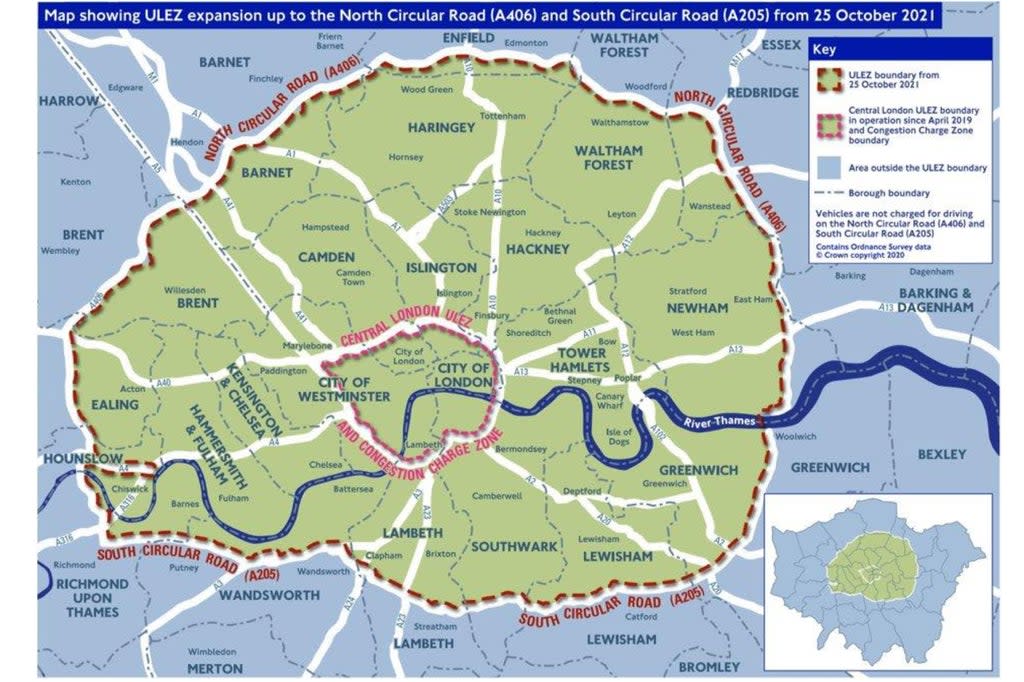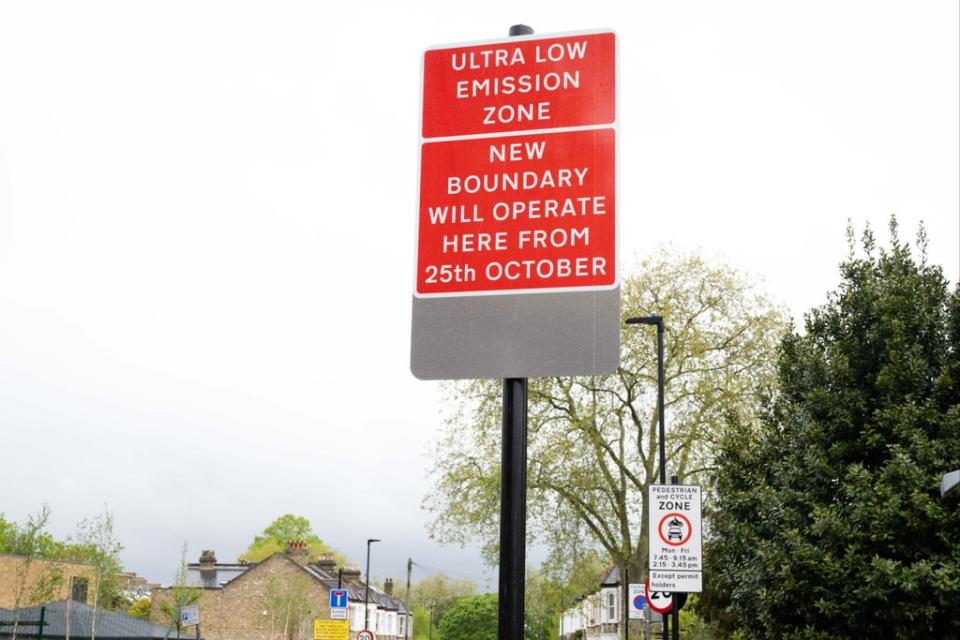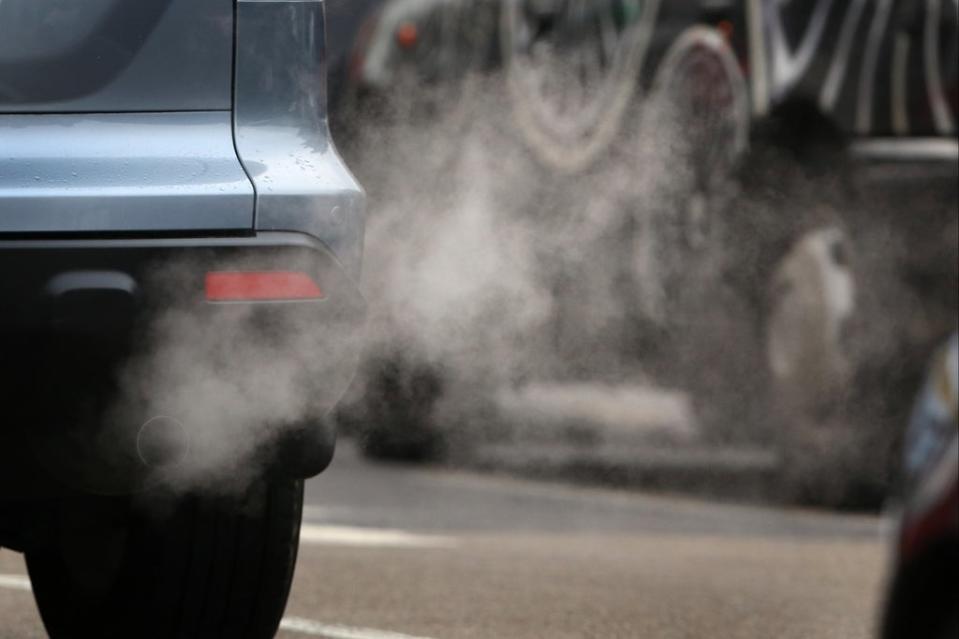When is the London Ulez expanding, where does it expand to and who will have to pay?

The ultra-low emission zone expanded from central London to the boundaries of the North and South Circular roads on October 25.
City Hall estimates that about one in five vehicles in the enlarged 140 square mile zone will be liable to pay the Ulez £12.50-a-day levy, including 100,000 cars, 35,000 vans and 3,000 lorries.
Here is everything you need to know ahead of the expansion, brought in to combat poor air quality in London, including who will be affected.
Who has to pay the Ulez?
The driver of a vehicle that fails to meet Transport for London’s exhaust emissions standards has to pay the Ulez charge.
Petrol vehicles require a Euro 4 engine to comply, and diesel vehicles a Euro 6 engine. Roughly speaking this means that petrol vehicles first registered after 2005, and diesel vehicles registered after 2015, will not have to pay.
What about motorbikes?
Motorbikes have to have a Euro 3 engine to escape the levy.
How can I find out if I have to pay the Ulez?
Visit the TfL website and enter the registration number for an instant check: https://tfl.gov.uk/modes/driving/check-your-vehicle/

Where do the Ulez rules apply?
The Ulez was launched in central London, in the same eight sq mile area as the congestion charge, in April 2019. It was extended to the inner boundaries of the North and South Circular roads on October 25. Anybody driving a vehicle either within the zone or across the zone’s boundary has to pay.
Does the Ulez charge just apply during the week?
No, unlike the C-charge, it applies 24 hours a day, seven days a week. The only day off is Christmas day.
How many vehicles are likely to have to pay the Ulez when it expands to the suburbs?
City Hall estimates that about one in five vehicles currently seen within the enlarged area will be liable – 100,000 cars, 35,000 vans and 3,000 lorries.
How much does the Ulez cost?
The daily charge is £12.50 for cars, vans and motorbikes and £100 for lorries and coaches.
The penalty for failing to pay is £160 for cars, vans and motorbikes and £1,000 for lorries and coaches.

Is the Mayor offering motorists any help?
Yes – but most of the £52m has already gone. Three scrappage schemes were set up, primarily for small businesses, low-income and disabled Londoners and charities. This has helped to replace or retro-fit almost 10,000 vehicles. Less than £10m is thought to remain.
For moderately well-off Londoners, for example those seeking to trade in a six-year old diesel, no help is available – the Mayor’s advice is to buy a slightly newer vehicle that automatically complies with the rules.
How much was available from the scrappage schemes?
People living in Greater London and receiving benefits were offered £2,000 to scrap a non-Ulez compliant car and £1,000 to scrap a non-Ulez compliant motorcycle or moped.
Small businesses and charities were offered £7,000 to switch to cleaner vehicles, with £9,500 available to those who switched to an electric alternative.
Small businesses and charities were offered £15,000 to replace or retrofit non-Ulez compliant heavy vehicles exceeding 3.5 tonne as well as buses, coaches, and minibuses exceeding five tonnes.
Do residents living within the enlarged zone get a discount or exemption?
No. Also, the 100 per cent discount for residents living within the central zone ended on October 24.
What happens if I drive my car more than once a day – do I pay each time?
No. One payment covers all driving within the 24-hour period, from midnight to midnight, regardless of whether you make one trip or 50.
Won’t the Ulez expansion simply increase pollution around the edges of the North and South Circulars as motorists seek alternative routes?
Scientists say the reverse is likely to happen – that the benefits of having “cleaner” vehicles in central and suburban London will extend beyond the boundary and help the entire capital, and beyond.
Dr Gary Fuller, a scientist from the School of Public Health at Imperial College London, said: “Many people worry about highly polluting vehicles diverting around the zone and moving the problem.
However, evidence from London’s original low emission zone [for lorries], the central Ulez and from schemes in Germany show that cleaner vehicles used inside the zone also drive in the areas around it, spreading the benefits.”
Read More
How much will the Ulez scheme cost me?
Ulez expansion: London’s pollution charge zone becomes 18 times larger
New app to save motorists ‘millions’ in fines as Ulez expands

 Yahoo News
Yahoo News 
